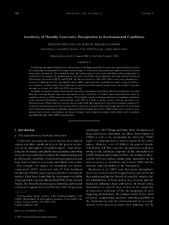| dc.creator | Myoung, Boksoon | |
| dc.creator | Nielsen-Gammon, John | |
| dc.date.accessioned | 2016-10-28T20:15:48Z | |
| dc.date.available | 2016-10-28T20:15:48Z | |
| dc.date.issued | 2010-01-01 | |
| dc.identifier.citation | Myoung, B., and J. W. Nielsen-Gammon, 2010: Sensitivity of monthly convective precipitation to environmental conditions. J. Climate, 23, 166-188, doi: 10.1175/2009JCLI2792.1. | en |
| dc.identifier.uri | https://hdl.handle.net/1969.1/158237 | |
| dc.description | © Copyright 2010 American Meteorological Society (AMS). Permission to use figures, tables, and brief excerpts from this work in scientific and educational works is hereby granted provided that the source is acknowledged. Any use of material in this work that is determined to be “fair use” under Section 107 of the U.S. Copyright Act September 2010 Page 2 or that satisfies the conditions specified in Section 108 of the U.S. Copyright Act (17 USC §108, as revised by P.L. 94-553) does not require the AMS’s permission. Republication, systematic reproduction, posting in electronic form, such as on a web site or in a searchable database, or other uses of this material, except as exempted by the above statement, requires written permission or a license from the AMS. Additional details are provided in the AMS Copyright Policy, available on the AMS Web site located at (https://www.ametsoc.org/) or from the AMS at 617-227-2425 or copyrights@ametsoc.org. | en |
| dc.description.abstract | Identifying dynamical and physical mechanisms controlling variability of convective precipitation is critical for predicting intraseasonal and longer-term changes in warm-season precipitation and convectively driven large-scale circulations. On a monthly basis, the relationship of convective instability with precipitation is examined to investigate the modulation of convective instability on precipitation using the Global Historical Climatology Network (GHCN) and NCEP–NCAR reanalysis for 1948–2003. Three convective parameters—convective inhibition (CIN), precipitable water (PW), and convective available potential energy (CAPE)—are examined. A lifted index and a difference between low-tropospheric temperature and surface dewpoint are used as proxies of CAPE and CIN, respectively.
A simple correlation analysis between the convective parameters and the reanalysis precipitation revealed that the most significant convective parameter in the variability of monthly mean precipitation varies by regions and seasons. With respect to region, CIN is tightly coupled with precipitation over summer continents in the Northern Hemisphere and Australia, while PW or CAPE is tightly coupled with precipitation over tropical oceans. With respect to seasons, the identity of the most significant convective parameter tends to be consistent across seasons over the oceans, while it varies by season in Africa and South America. Results from GHCN precipitation data are broadly consistent with reanalysis data where GHCN data exist, except in some tropical areas where correlations are much stronger (and sometimes signed differently) with reanalysis precipitation than with GHCN precipitation. | en |
| dc.language.iso | en_US | |
| dc.publisher | American Meteorological Society | |
| dc.subject | reanalysis | en |
| dc.title | Sensitivity of Monthly Convective Precipitation to Environmental Conditions | en |
| dc.type | Article | en |
| local.department | Atmospheric Sciences | en |
| dc.identifier.doi | 10.1175/2009JCLI2792.1 | |


